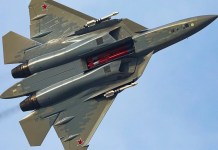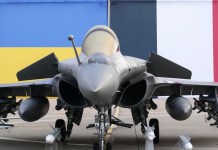Russia quietly sold Myanmar $15M worth of military equipment including Orlan-10E surveillance drones and Pantsir missiles earlier this year.
Apparently, Russian Defense Minister Sergei Shoigu agreed to supply Myanmar with Pantsir-S1 surface-to-air missile systems, Orlan-10E surveillance drones and radar equipment during a visit to the capital Naypyidaw in January.
The deal was made a week before a military coup ousting Aung San Suu Kyi and President Win Myint, which brought an end to a decade of civilian rule.
However, from the point of view of the arms business, what is most significant is that by selling Orlan-10E drones to Myanmar, Russia has taken the first step into the unmanned aircraft market.
In fact, by so doing, Russia seems to have changed its past policy on selling drones in the international market.
Since a drone is a “flying robot” with a propulsion system, an energy store and several control systems, as well as with remote communication elements having a base and the people operating it, Russia, in 2017, had declared its support to the “Stop Killer Robots” campaign.
This campaign was based on the rationale that since lethal systems with autonomous weapons were a complex issue raising many issues, countries should restrain from proliferating them before fully understanding the situation.
However, in November 2018, at the United Nations Convention on Certain Conventional Weapons (CCW), Russia modified its stance by saying that discussions on fully autonomous weapons were a threat to scientific and technological progress and that any proposal towards a ban on these weapons was somewhat unfounded and counterproductive.
Russia maintained this ambiguous position on drones at the CCW meetings during 2019. While it still did not contemplate exporting autonomous weapons like drones, it encouraged the Russian military complexes to work together with research centers for the development of weapons systems with increasing autonomy in various functions. And these included drones.
Russian Drones
Apart from Orlan, in recent years drones manufactured by Russia include the Lantset series (Lantset-1 and Lantset-3), KUB-BLA29, Eleron-3, Sukhoi S-70 (known differently as Okhotnik-B or Hunter), Karnivora and Orion-E (MALE).
However, it may be noted that all these drones, except Orlan, are at different stages of development, some of them like the Lantset series and Hunters being at the advanced stages of mass production. Of course, many of their pilot versions have been tried or experimented not only in Russia but also in Syria and Iraqi battlefields. Some of them have been exhibited also in various air shows and defense exhibitions.
Secondly, most of them will be first used by Russian armed forces before being considered for exports. Analysts monitoring the Russian press say that large-scale delivery of the drones, particularly those combat drones equipped with sophisticated and powerful missiles will be necessary as Russia is believed to lag behind the United States in this field.
It appears that the Russian military is trying to develop UAV technology to fill a tactical niche in the battlespace to compete with cruise missiles and manned aircraft. If more fully developed, UAVs would be able to offer a more efficient and less expensive solution to the task of engaging a wide range of enemy ground and surface targets with fires.
This explains why the ongoing modernization of Russia’s Armed Forces is attaching great significance to developing and exploiting unmanned aerial vehicles (UAV) and unmanned combat aerial vehicles (UCAV). In Russian military exercises and on the battlefield in Ukraine and Syria, the overwhelming use of UAVs has focused on reconnaissance to enable improved target acquisition.
Export Potential
With regard to exports, emphasis, to begin with, is now on the Orlans as these are similar to the US Predator XP and the Israeli Heron in their unarmed reconnaissance version.
But with the US, Israel and China exporting combat versions of the Heron TP, Hermes 900 drones, Predator B, CH-5 and Wing Loong II to several countries in the Middle East, Africa and Central Asia, Russia is likely to change this practice also, given the importance of arms-exports to its economy.
As it is, the 2021 calendar that has been released by the Russian Ministry of Defense includes a heavily retouched image of the Orion-E carrying KAB-20 guided bombs — a 44-pound weapon.
It may be noted that the Orion-E fitted with weapons was demonstrated by Rosoboronexport at the IDEX 2021 expo in Abu Dhabi in March. This was the first official presentation of this drone in the armed configuration at the foreign expo.
That Russia is now ready to export the UAV (with a gross weight of around 2,250 pounds, an endurance of up to 24 hours and speed up to 200 km per hour) for combat purposes too became evident with Rosoboronexport and Kronshtadt, the producer of Orion-E expressing their “readiness to promote it to partners from the Asia-Pacific region, Middle East and North Africa.”
At the Abu Dhabi IDEX, Russia had also promoted the Orlan-10E UAV system side by side.
Coming back to ready to export Orlan-10, it has a wingspan of 10 feet and a maximum takeoff weight of about 35 pounds, including a 10-pound payload. It can cruise for up to 18 hours at 70 mph, and can be controlled from about 90 miles away. Though Russians claim that this drone can drop bombs, its authenticity has not been proved yet by the experts.
It is a medium-range, multi-purpose unmanned aerial vehicle (UAV) developed by the Russian firm Special Technology Center LLC in St Petersburg. It can perform a variety of missions including aerial reconnaissance, observation, monitoring, search and rescue, combat training, jamming, detection of radio signals, and target tracking in hard-to-reach terrains.
In fact, the Orlan-10 has been widely used in Syria, Armenia, Ukraine and elsewhere in the reconnaissance role.




